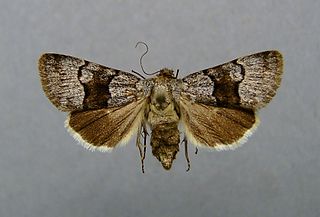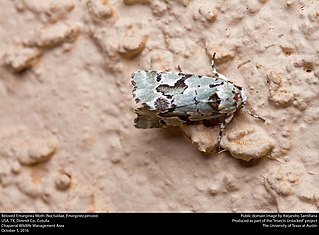
Lepidoptera is an order of insects that includes butterflies and moths. About 180,000 species of the Lepidoptera are described, in 126 families and 46 superfamilies, 10 percent of the total described species of living organisms. It is one of the most widespread and widely recognizable insect orders in the world. The Lepidoptera show many variations of the basic body structure that have evolved to gain advantages in lifestyle and distribution. Recent estimates suggest the order may have more species than earlier thought, and is among the four most species-rich orders, along with the Hymenoptera, Diptera, and Coleoptera.

Moths are a group of insects that includes all members of the order Lepidoptera that are not butterflies. They were previously classified as suborder Heterocera, but the group is paraphyletic with respect to butterflies and neither subordinate taxa are used in modern classifications. Moths make up the vast majority of the order. There are thought to be approximately 160,000 species of moth, many of which have yet to be described. Most species of moth are nocturnal, although there are also crepuscular and diurnal species.

The Noctuidae, commonly known as owlet moths, cutworms or armyworms, are a family of moths. They are considered the most controversial family in the superfamily Noctuoidea because many of the clades are constantly changing, along with the other families of the Noctuoidea. It was considered the largest family in Lepidoptera for a long time, but after regrouping Lymantriinae, Catocalinae and Calpinae within the family Erebidae, the latter holds this title now. Currently, Noctuidae is the second largest family in Noctuoidea, with about 1,089 genera and 11,772 species. This classification is still contingent, as more changes continue to appear between Noctuidae and Erebidae.

Orgyia is a genus of tussock moths of the family Erebidae. The genus was described by Ochsenheimer in 1810. The species are cosmopolitan, except for the Neotropical realm.

Amphipyrinae is a subfamily of owlet moths in the family Noctuidae. There are more than 50 genera and 210 described species in Amphipyrinae, although the classifications are likely to change over time.

Aleptina is a genus of moths of the family Noctuidae. The genus was erected by Harrison Gray Dyar Jr. in 1902.
Crimona is a genus of moths of the family Noctuidae erected by John Bernhardt Smith in 1902.
Viridemas is a monotypic moth genus of the family Noctuidae. Its only species, Viridemas galena, is found in the US state of Arizona. Both the genus and species were first described by John Bernhardt Smith in 1908.

Eulithosia is a genus of moths of the family Noctuidae erected by Henry Edwards in 1884.
Lythrodes is a genus of moths of the family Noctuidae. The genus was erected by John Bernhardt Smith in 1903.

Netrocerocora is a monotypic moth genus of the family Noctuidae erected by Max Bartel in 1902. Its only species, Netrocerocora quadrangula, was first described by Eduard Friedrich Eversmann in 1844 as Noctua quadrangula.
Nocloa is a genus of moths of the family Noctuidae. The genus was erected by John Bernhardt Smith in 1906.

Oxycnemis is a genus of moths of the family Noctuidae. The genus was erected by Augustus Radcliffe Grote in 1882.

Podagra is a monotypic moth genus of the family Noctuidae. Its only species, Podagra crassipes, is found in the US state of Arizona. Both the genus and species were first described by John Bernhardt Smith in 1902.

Psaphida is a genus of moths of the family Noctuidae. The genus was erected by Francis Walker in 1865.

Sympistis is a genus of moths of the family Noctuidae. The genus was erected by Jacob Hübner in 1823.

Tristyla is a monotypic genus of moths in the family Noctuidae. Its only species, Tristyla alboplagiata, is found in the US states of California and Arizona. Both the genus and species were first described by John Bernhardt Smith in 1893.

Oxycnemis advena is a moth of the family Noctuidae first described by Augustus Radcliffe Grote in 1882. It is found in southwestern North America in the mountains of southern Arizona, eastern Nevada, southern California and southern Baja California.

Psaphidini is a tribe of owlet moths in the family Noctuidae. There are at least 40 genera and at least 90 described species in Psaphidini.
Oxycnemis grandimacula is a species of moth in the family Noctuidae. It was first described by William Barnes and James Halliday McDunnough in 1910 and it is found in North America.












